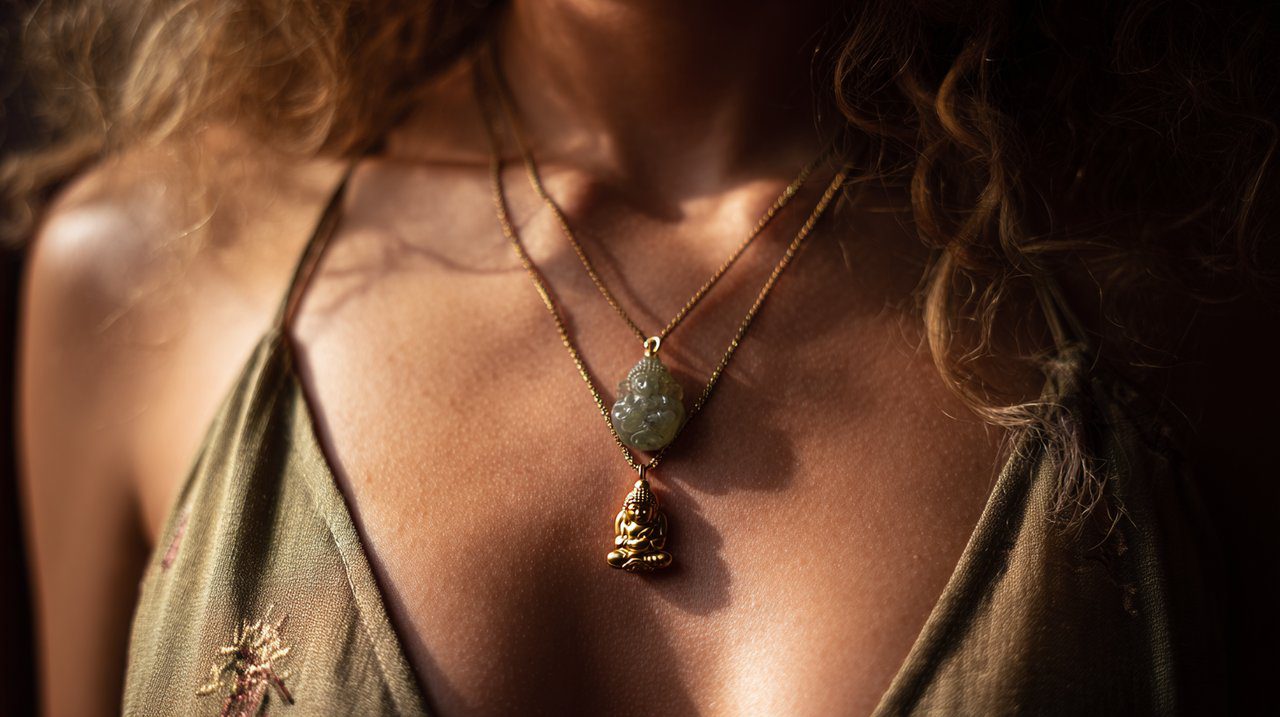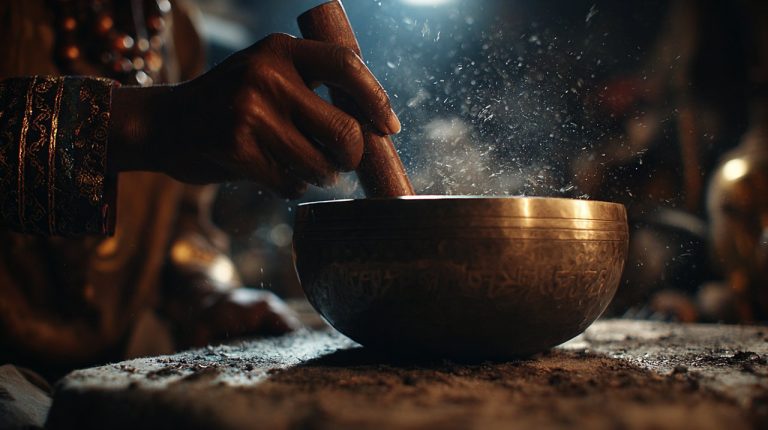Wearing Multiple Buddha Necklaces: A Guide to Intent, Reverence, and Symbolism
When contemplating the wearing of spiritual ornaments, such as a Buddha necklace or prayer beads, a fundamental inquiry often surfaces: Does mere quantity hold significant weight? This question becomes particularly pertinent for items as deeply symbolic as Buddha necklaces, frequently manifesting as queries like, “can one wear two Buddha necklaces,” or even more. Such curiosity extends far beyond mere fashion; it delves into the very essence of reverence, the nuanced understanding of energetic principles, and the profound expression of personal intention.
This guide transcends a simplistic affirmative or negative, offering instead a deeper exploration into how to select and wear Buddha necklaces with greater wisdom and respect, thereby transforming these spiritual adornments into authentic conduits of inner strength and profound insight.

Intent as the Foremost Anchor of Spiritual Adornment
Before delving into the specifics of quantity or style concerning Buddha necklaces, a foundational principle demands establishment: intent serves as the indispensable cornerstone of all spiritual practice. The true potency of a Buddha necklace does not emanate from its material value or its numerical presence, but rather from the wearer’s inner conviction, profound reverence, and the aspirations it embodies.
“Everything is created by the mind alone.” — Avatamsaka Sutra (Flower Garland Sutra)
This ancient Buddhist wisdom succinctly illuminates the decisive role of the mind in shaping our reality—a principle equally applicable to our contemplative relationship with spiritual ornaments. Indeed, wearing a Buddha necklace is akin to constructing an inner sanctuary. Each piece of adornment, when chosen with mindfulness, should serve as a deliberate building block within this sanctuary, its value measured by how seamlessly it aligns with one’s spiritual pursuit and personal evolution. Without this clear intent, even a multitude of Buddha images risks diminishing into mere decorative items, losing their inherent spiritual resonance.
Paramount Reverence: Universal Etiquette for Wearing Buddha Images
Whether one chooses to wear a single Buddha necklace or multiple, the paramount consideration remains reverence. This extends beyond mere respect for the Buddha himself, encompassing a broader deference to Buddhist culture and its profound, millennia-old teachings.
From a practical standpoint, it is essential to ensure the Buddha image remains clean and well-maintained. Furthermore, one should conscientiously avoid wearing it in unhygienic environments or during activities that could be deemed disrespectful, such as bathing. Many traditions thoughtfully suggest positioning Buddha images above the waist, a gesture that universally signifies honor and profound respect.
It is a common misconception to treat a Buddha image as solely a fashion accessory. Such a “light regard” not only disregards its sacred significance but may also inadvertently diminish the positive energy and spiritual resonance inherent in the adornment itself.
Strategic Layering: Harmonious Coexistence of Multiple Buddha Necklaces
Regarding the frequently asked question, “can you wear two Buddha necklaces,” the answer is not a simple “yes” or “no.” Instead, it is contingent upon the deliberate manner in which they are layered. The underlying principle here is to cultivate a harmonious energetic field, meticulously avoiding any visual or spiritual clutter.
Strategic considerations for layering include:
- Energetic Coordination: Reflect upon the distinct energies represented by various Buddha figures (e.g., Maitreya, Avalokiteshvara) or the inherent qualities of different materials. The aim is to select combinations where these energies either complement each other or collectively converge towards a shared objective, such as the cultivation of wisdom and compassion.
- Material and Length: For instance, a gold chain with a Buddha pendant can be thoughtfully paired with a jade Buddha necklace of a different length. Varying materials, colors, and lengths contributes to visual depth and prevents a cluttered appearance, allowing each piece to retain its distinct presence.
Consider the case of a practitioner who might simultaneously wear a jade pendant of Avalokiteshvara, symbolizing boundless compassion, alongside a golden image of Manjushri, representing profound wisdom. This approach transcends mere numerical addition; it powerfully signifies the integrated manifestation of two vital spiritual qualities within the wearer’s being, transforming adornment into a deeper personal narrative.
Material Symbolism: Energetic Interpretations of Gold and Jade
The choice of material for a Buddha necklace—be it a gold chain with Buddha or a Buddha jade necklace—inherently carries distinct cultural and energetic connotations. Understanding these meanings can profoundly guide one in making selections that resonate with personal needs and aspirations.

Gold Chain with Buddha
- Symbolic Significance: Gold has historically been revered across civilizations as a symbol of wealth, purity, and eternity. Within Buddhist iconography, the resplendent color of gold is frequently associated with the Buddha’s “golden body” and his perfect, unblemished wisdom. Wearing a golden Buddha may thus signify a pursuit of prosperity, success, and ultimately, spiritual enlightenment.
- Energetic Qualities: Gold is widely believed to possess potent positive energy, capable of attracting good fortune and significantly enhancing the wearer’s confidence and inner strength.
Buddha Jade Necklace Meaning
- Symbolic Significance: In Eastern cultures, jade is celebrated as the “stone of kings,” embodying purity, auspiciousness, longevity, and profound wisdom. The meaning associated with a Buddha jade necklace is commonly linked with protection, deep tranquility, and holistic well-being.
- Energetic Qualities: Jade is thought to possess a gentle, nurturing energy, uniquely capable of balancing emotions and fostering an abiding sense of peace and harmony. This makes it particularly suitable for those seeking inner serenity or a profound spiritual refuge.
In a comparative selection, if the aim is to amplify personal aura and manifest external success, gold might be the more appropriate choice. Conversely, if one seeks inner peace, robust health, and spiritual protection, jade could prove to be a superior companion. It is crucial to note that these choices are not mutually exclusive; they can be harmoniously combined based on one’s current personal needs and spiritual journey.
Inner Connection: Discovering Your Unique Spiritual Emblem
Ultimately, the wearing of a Buddha necklace, irrespective of quantity or material, must always circle back to your inner connection with the Buddha image. This represents not just a choice of adornment, but a profound personal practice and a nuanced form of self-expression.
Key elements that foster this connection include:
- Personal Resonance: Which particular Buddha figure or material most profoundly resonates with your spirit? Opt for pieces that genuinely evoke feelings of peace, inspiration, or empowerment within you.
- Continuous Practice: Wearing a Buddha image is not a singular, static act. Through daily meditation, consistent acts of kindness, or dedicated study of Buddhist teachings, continuously nurture your connection with the Buddha. This ongoing engagement allows the necklace to truly serve as a potent reminder and a steadfast companion on your spiritual journey.
Before deciding to wear multiple Buddha necklaces, engage in a period of thoughtful introspection. Ask yourself: What distinct message does each necklace signify to me? What collective narrative or spiritual aspiration do they convey when worn together? This deliberate contemplation will infuse your act of wearing with profound power and authentic meaning, transforming simple adornment into a conscious spiritual practice.
Conclusion: The Enduring Guidance of Intent and Reverence
The practice of wearing Buddha necklaces, whether singly or in multiples, fundamentally hinges upon the purity of one’s intent and the depth of one’s reverence. As we have explored, from understanding the foundational role of intention and adhering to universal etiquette, to the art of strategic layering, discerning the nuanced symbolism of materials, and cultivating a deep personal connection, each step builds an invaluable bridge between the wearer and sacred wisdom.
Recall our initial inquiry regarding quantity. It becomes clear that the “more” is not in the number of pieces, but in the depth of mindful engagement. Your physical form is, in essence, a temple for your spirit, and the adornments you choose are sacred symbols within that very sanctuary. May each instance of wearing these profound emblems be filled with heightened awareness, serving as a serene yet powerful light illuminating your path of spiritual practice and growth.
💡 Frequently Asked Questions
The most important principle is the wearer's intent, inner conviction, profound reverence, and the aspirations the necklace embodies. Its true potency does not come from its material value or numerical presence.
Yes, it is essential to ensure the Buddha image remains clean and well-maintained. One should avoid wearing it in unhygienic environments or during disrespectful activities, and many traditions suggest positioning Buddha images above the waist to signify honor and respect. It should not be treated as solely a fashion accessory.
Yes, multiple Buddha necklaces can be worn together, but it depends on deliberate layering to cultivate a harmonious energetic field. Considerations include energetic coordination (selecting complementary energies), and varying materials, colors, and lengths to prevent a cluttered appearance.
Gold symbolizes wealth, purity, and enlightenment, believed to attract good fortune and enhance confidence. Jade, conversely, embodies purity, longevity, and protection, possessing a gentle, nurturing energy that balances emotions and fosters peace and harmony.







